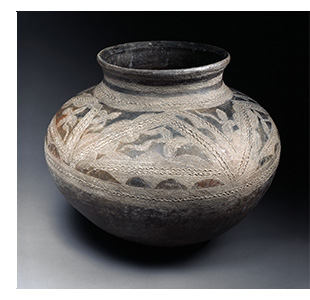Emory is dedicated to increasing the sustainability of the university, including reducing its water consumption by 50% between 2015 and 2025. To do this, it has developed the WaterHub, a water recycling system located on campus to clean up to 400,000 gallons of waste water per day. Thinking about the way an abundance of water has led to innovative ways to conserve it also makes me think about the way in which a scarcity of water has led to meaningful ways to display its value.
 Water is necessary for everyone, but not readily accessible for many people in rural parts of Africa, so women make daily trips to the closest potable water source, carrying their water for the day in containers atop their heads. This daily task is so deeply embedded in the Makonde culture in northern Mozambique that women commission or make a custom water pot like the vessel in our collection. These pots continue to be used to carry water and to store it, keeping it cool throughout the day, just like a brightly colored insulated water bottle.
Water is necessary for everyone, but not readily accessible for many people in rural parts of Africa, so women make daily trips to the closest potable water source, carrying their water for the day in containers atop their heads. This daily task is so deeply embedded in the Makonde culture in northern Mozambique that women commission or make a custom water pot like the vessel in our collection. These pots continue to be used to carry water and to store it, keeping it cool throughout the day, just like a brightly colored insulated water bottle.
On this container, the potter engraved emblems of Medicago Sativa, or alfalfa, surrounded by scallop-edged triangular bands. She would have then applied a kaolin wash to the surface, which wears away over time, leaving behind a whitened pattern in the grooves of the stipple and hashes and highlighting the raised zigzags.
Ceramic pots can be embellished with individualized patterns and designs, often corresponding to a woman’s tattoos that were once a widespread practice. Indeed, the Makonde word for drawing or engraving designs on pottery, nkova, also refers to tattooing or incising cicatrization marks. Thus, it is a unique expression of the owner’s identity that she will keep for her entire life. The decorated pot carried on a woman’s head thus becomes a visual extension of her body.
You can learn to make a clay vessel of your own by watching one of the videos ceramicist and teaching artist Ana Vizurraga has created. Whether you choose to make a pinch pot or a coil pot, you can add designs that reflect your own personality to the pot’s exterior.
You may also enjoy this video in which Tiphanie Yanique, an author and associate professor of creative writing at Emory, reads The Water Princess, a book inspired by fashion model Georgie Badiel’s story of growing up in rural Burkina Faso and her dream to make clean water accessible to her town.
In 2015, Badiel established the Georgie Badiel Foundation to build wells across the country and plant trees to combat desertification. Enterprises like this, along with conservation efforts like Emory’s, will ensure that instead of the global demand for water exceeding its supply, we will all have access to clean water.





